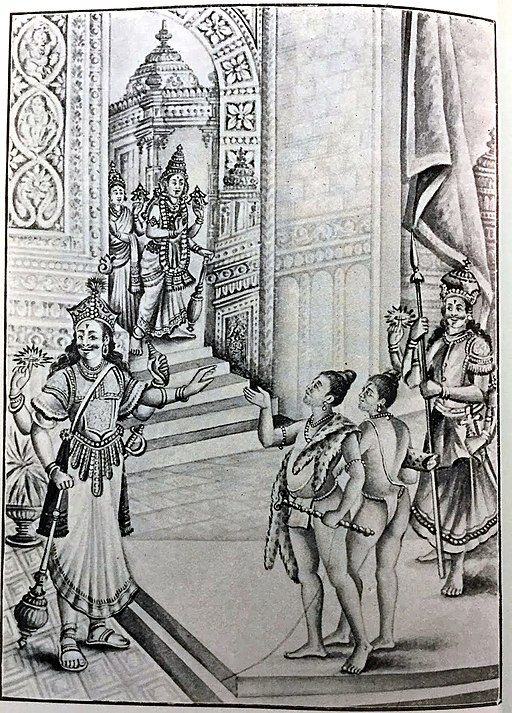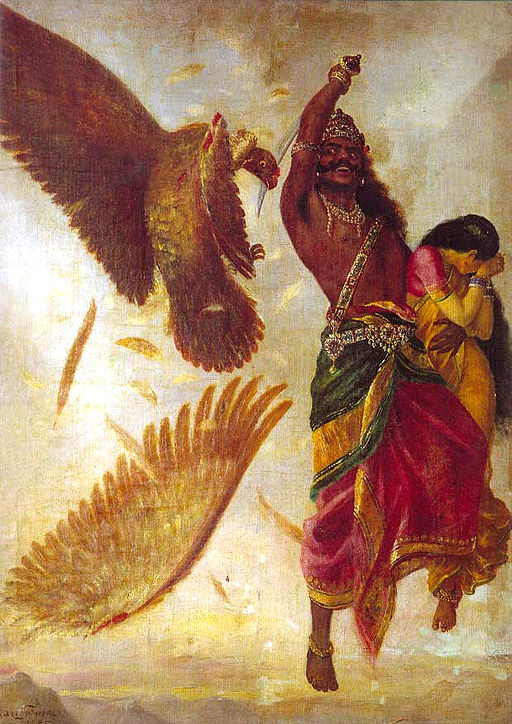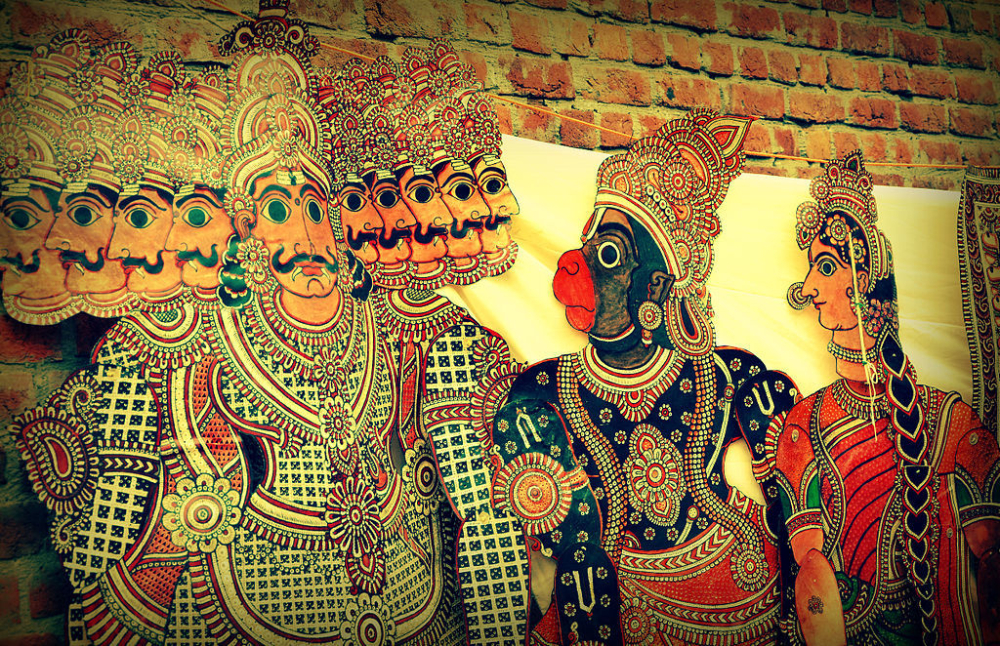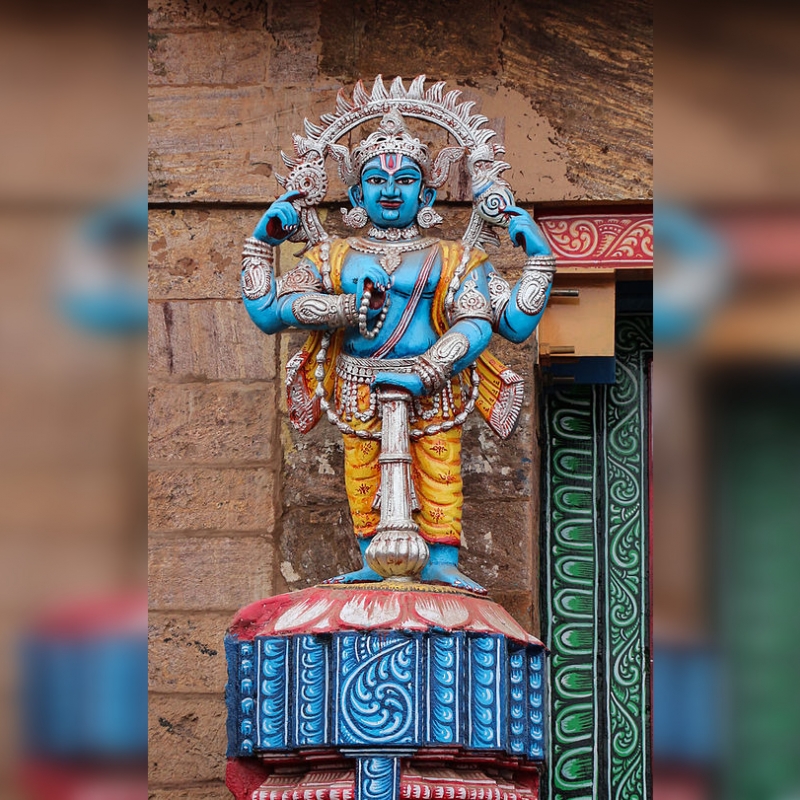For many, the characters in the Ramayana are essentially straightforward. Rama is the hero, Sita is the heroine and Ravana is the villain. However, those familiar with Hindu mythology would know there is nothing simple or linear about such epics. Here, we explore the different narratives that reveal how Ravana was once Vishnu’s true devotee. (In pic: Statue of Vijaya at the entrance of the Jagannath Temple, Puri; Photo Courtesy: Bernard Gagnon [CC BY-SA 3.0])
Why was Ravana so resolute in heaping ignominy upon himself? As the ‘inglorious’ foil to Rama, this unfavourable image would forever be associated with his name.
In popular culture, we know of Ravana and his brother, Kumbhakarna, as rakshasas—cruel, covetous, wrathful and lustful. But what if this is only part of the picture, the cause of which lies hidden in an unseen past?
Ravana is said to have been a poet of considerable merit. The famous Shivatandava Stotra is attributed to him, along with several Sanskrit works such as Arkaprakash, Kumar Tantra, Indrajaal, Prakritakamadhenu, Prakritalankeshwar and Rigveda Bhashya. Interestingly, he also has a compelling backstory that explains his inimical equation with Rama. In a lecture on avataras in 1899, British activist and theosophist Dr Annie Besant asks, ‘[Ravana was the] keeper of Vishnu’s heaven, doorkeeper of the mighty Lord… bhakta, absolutely devoted to the Lord... How did he then come to be… the enemy of God…?’[i]
This is explained in ancient texts such as the Bhagavata Purana[ii] and the Ramacharitamanasa.[iii] The texts tell us of a series of curses that deliver two colossal characters—Ravana and Kumbhakarna—to our mythology. One well-recounted tale is of Jaya and Vijaya, twin parshadas (attendants) who fall from Vaikuntha. One day, Brahma’s ‘mind-born’ sons—Sanaka and other sages—visit Vishnu. They look like little boys but are, in reality, old and spiritually advanced. Unable to discern their true forms, Jaya and Vijaya refuse them passage. After they forcefully enter Vishnu’s abode, the angry sages curse Jaya and Vijaya, saying they will fall from Vaikuntha into the lower worlds of materiality.

‘The worst punishment, according to the Vedas is coming back to earth,’ Swami Vivekananda once said.[iv] The omniscient Vishnu bows to the curse of Sanaka and the sages, and reveals to his bhaktas the curse behind the curse: the two had also been cursed by Lakshmi when they prevented her from seeing the Lord. In the Bhagavata Purana, Vishnu explains to Jaya–Vijaya that their salvation lies in taking their earthly journey, full of loathing for him, so they can be delivered from the sages’ curse and return to him.
In Balarama Das’ Dandi Ramayana, Chanda and Prachanda—doorkeepers of Narayana—are cursed by Lakshmi when they refuse her entry to the Lord. Reassuring them that they will join him at the end of their sentence, Narayana suggests that they go through the period of punishment as the great rakshasas Jaya–Vijaya—conquerors of the earth. Lakshmi, who has allowed her anger to get the better of her, shall be reborn as Sita.[v]
Often, a curse comes with an antidote. In the scriptures, this solution came with a choice: Jaya and Vijaya can choose to be reborn seven times as devotees of Vishnu, or three times, in which they will be his bitterest enemies.[vi] Because the two are true bhaktas, they choose the latter. If returning to their Lord at the earliest means being vilified forever on earth, so be it. ‘Better a short time of utter enmity than a longer remaining away with apparent happiness. It was love, not hatred, which made him choose the form of rakshasa rather than of a rishi,’ explains Besant.

The two are born first as daityas—Hiranyaksha and Hiranyakashipu. Vishnu is born as Varaha and Narasimha, respectively, to kill the two.[vii] Next, they are reincarnated as Ravana and Kumbhakarna, spearheading adharma before falling to the arrows of Rama.
Ravana carries out his duty, rallying all the forces of evil against the Lord so that Vishnu will descend as Rama to destroy him, ultimately delivering him from the curse. In a throwback to Hiranyaksha, who stole the earth goddess, Ravana kidnaps Sita so that Rama can fulfil his mission on earth as an avatara of Vishnu. Rama kills Ravana, and the devotee joins his Lord in Vaikuntha for a while before returning to earth in his third incarnation. Born as Shishupala and Dantavaktra, Jaya and Vijaya are slain by Vishnu in his manifestation as Krishna.
In the Ananda Ramayana, the two Asvinikumaras curse Jaya and Vijaya to be born as rakshasas.[viii] In the first sarga (chapter) of the Ramalingamrita, Rishi Durvasa curses them when they stop him from entering Vishnu’s quarters.
Elsewhere, in the tradition of Ramakatha, it is said that ‘a host who is cursed by a Brahman for having been unwittingly served a meal of human flesh is also redeemed by Rama’. As part of this lore, the Ramacharitamanasa talks of King Pratapbhanu, who is born as Ravana after he is cursed by Brahmans for feeding them human flesh.[ix]

Several Puranas tell us of the daitya Jalandhar, who is reincarnated as Ravana in a later birth. Vrinda, his chaste wife, is seduced by Vishnu (disguised as Jalandhar) with the help of Jaya–Vijaya. When she discovers the truth, Vrinda curses them and Vishnu as well: they will be born as rakshasas and abduct the wife of Vishnu, who will descend in human form to stop them. [x] The Ramacharitamanasa also mentions this story in passing.
Across these narratives, there are several versions that mention the pronouncer of the curse. However, there is only one redeemer—Vishnu. Many of his devotees choose to be reincarnated as daityas or rakshasas, following the path of ‘evil’. And though it may take much pain from which ensues much learning, they are ready to join Vishnu once again when the lesson is learnt.
This article was also published in The Statesman.
Notes
[i] Annie Besant, ‘Avataras’ (second lecture delivered at the 24th anniversary meeting of the Theosophical Society, Madras, Tamil Nadu, December 1899), accessed July 24, 2019, https://www.scribd.com/document/236093214/Annie-Besant-Avataras.
[ii] Bhagavata Purana (Gorakhpur: Gita Press, 2003), 3:15–16. References here are to skandha (book) and chapter numbers.
[iii] Ramacharitamanasa (Gorakhpur: Gita Press, 1988), 1:121:2–3 and 1:122:1.
[iv] Swami Vivekananda, Practical Vedanta (Kolkata: Advaita Ashrama, 2004).
[v] Camille Bulcke, Ramakatha: Utpatti aur Vikas (Allahabad: Hindi Parishad, 1950).
[vi] Ibid. Also see Bhagavata Purana (Gorakhpur: Gita Press, 2003), 7:1:35–46; Ananda Ramayana (Delhi: Chaukhamba Sanskrit Pratishthan, 2013), 7:14:1–27. References here are to skandha, chapter and verse numbers.
[vii] Bhagavata Purana (Gorakhpur: Gita Press, 2003), 3:19 and 7:8.
[viii] Ananda Ramayana (Delhi: Chaukhamba Sanskrit Pratishthan, 2013), 7:14:1–27.
[ix] Ramacharitamanasa (Gorakhpur: Gita Press, 1988), 1:153:1–4 to 1:176:1–4.
[x] Camille Bulcke, Ramakatha: Utpatti aur Vikas (Allahabad: Hindi Parishad, 1950).













